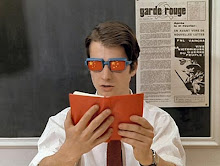reviewed for Chester Records
It’s nice to know that no matter how strong the possible (hell! probable) impulse toward contemporaneousness lurking inside the furrowed folds of the current rock scene, that we have bands like The Gaye Blades intermittently popping up to disrupt the tyranny of being up to date.
Featuring members of such esteemed junk rock heavyweights as Black Lips, Gentleman Jesse and his Men and The Carbonas, The Gaye Blades can perhaps register as a bit of a lark. Side bands have a tendency to do that, particularly when they lean toward a template of boisterous party-throttling instead of the urge to either break new ground or reinforce the prevailing streams of the time.
And that’s how it should be. The allure of the one-off record has generally been about shoving aside expectations and getting back to the basics of what I like to call Pure Throwing Down. And this applies equally to the rumbles from undeniably star-studded affairs as it does to the doing it for the sheer hell of it discographical asides issued by more underground figures. Actually, after giving it some consideration, it’s in the low-expectation/high performance zone of the side band that household names and comparatively unheralded toilers can join together in celebration of the goodness inherent in rock’s economy of scale. It’s where the sweet studio screwery of the Hopkins Cooder Wyman Jagger Watts Jamming with Edward or the bruising Stoogeoid mess-around of the Moore Shelley Fleming Hell Dim Stars material rubs shoulders with The Gaye Blades and their Norton label mates The Ding-Dongs (comprised of neo-garage heavy-hitter Mark Sultan and Canadian rockabilly manic Bloodshot Bill, dontcha know).
If operational shoulder rubbing between these four examples is extant (and I certainly think it is) then it’s also with the Blades and the Dongs that we can glimpse some deeply conspiratorial, in fact almost coital, communion. For in both groups (the Blades a kinetic if appealingly featherweight four-piece, the Dongs a stripped down and dirty duo) there is a determined predilection for the plundering the essence of uncut ‘50s rock ‘n’ roll exaltedness. This is getting to be something of a trend (especially if any revived rock moves of a pre-Beatles vintage are equated with “the 1950s”) and I can’t say I’m the slightest bit displeased. I mean, who would’ve thought that doo-wop, Spector, ‘billy and horn-honking R&B would become a small but viable part of the current u-ground state of affairs, much less one with an actually hip cadre of fans? Not me, but I’m as pleased as a punch drunk Shriner that I can revel in this rich mulch instead of sitting on a stump contemplating the contempo relevance of dubstep. Zing!
And if that mention of hipness worries you (shiver me timbers!), please relax. The main attribute keeping this batch of backward-looking upstarts from falling into the pits of style over substance (thus far) is the endeavor of getting right down to brass tacks on cheap instruments in practice spaces over all and sundry. That and a sincere dedication to songs. This naturally helps heaps in not only not sounding like this month’s flavor, but also in not sounding like the other bands within their similar sonic temperament.
For instance, The Gaye Blades differ significantly from The Ding-Dongs in concept and execution. Where the latter actually manage to sound like a long-lost and loopy slab of throbbing rockabilly meat, the former come off like a bunch of smart teens who while out searching for musical inspiration ended up unsuspectingly waylaid by somebody’s ultra-cool uncle’s record collection, the kids opportunistically absorbing wholesale moves and then applying them to a handful of brilliantly basic songs in the admirable attempt to win their high school’s battle of the bands. Did they do it? Well, if not the damned thing was rigged.
As should be obvious, The Gaye Blades self-titled 10-song LP is very much cut from Ramones-like cloth, though in concept not in execution, being much sunnier in disposition, though by no means oppressively so. One more time: this is ‘50s inflected power-popish (read: not pop-punkish) R&R with harmonies and hooks by the bushel. But unlike the Ding-Dongs, it all sounds just as likely to have been made last week as in the days of 1976. And that’s a fine duality to consider.
It may seem like I’ve spent the majority of this review talking around The Gaye Blades instead of about them, and that’s not incorrect. Fact is, bands of this level of simplicity and directness are somewhat resistant to extended analysis. The concept is extremely basic; the songs get down onto disc and it either succeeds or fails or falls somewhere in between. But the context of the concept is always worth a few hundred words. And when the knob is turned way up so that for a few too brief moments everything feels alright in the world, the music shines like a diamond.


No comments:
Post a Comment